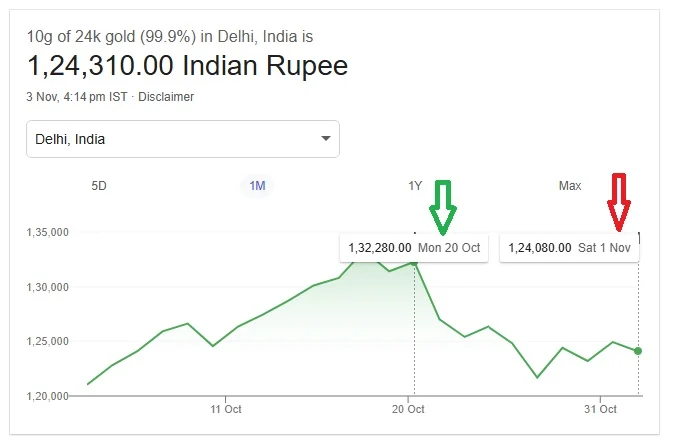The question “should I invest in gold” comes up often, especially when the price of gold is climbing, economies are uncertain, and news/social media talk about how gold performed in recent years. With such input, it is easy to get influenced and take investment decisions based on what people say. The challenge in such a situation is to keep yourself calm and separate the myths from the facts so you can decide whether exposure to gold belongs in your portfolio, and if so, how much, in what form, and for what purpose. As a fee-only financial advisor, I aim to help you make informed decisions using financial planning that best suits your financial goals. In this article, we will cover all the aspects as a comprehensive guide for gold investment.

What Does “Investing in Gold” Mean? (Forms & Modes)
Physical gold: Coins, Bars, Jewelry
One of the most familiar ways for individual investors to buy gold in India is through physical gold—that means coins, bars, or jewellery. With physical holdings, you are exposed to storage and security risk, but you also have a tangible asset in your hand, which gives satisfaction if it’s in a small quantity and tension if it’s worth lakhs.
Paper/Digital gold
- Gold ETFs (Exchange-traded funds) give you exposure to the yellow metal without the need to manage physical storage. It tracks the gold price and an increasingly popular “paper gold” route. You can buy Gold ETFs just like you buy stocks via a demat account.
- Gold mutual funds / FoFs (funds of gold ETFs or gold-linked) – These are mutual fund schemes (or funds-of-funds) that invest in gold ETFs or gold-linked assets, offering another route for gold exposure. It’s easy to buy gold with a mutual fund in a systematic manner using SIP.
- Digital gold platforms – Some platforms in India offer fractional ownership of gold (e.g., online “digital gold” schemes). They are easy to buy with no storage risk, but carry unique risks (custody, regulation, liquidity). I suggest staying away from digital gold as it is not regulated.
- Sovereign Gold Bonds (SGBs)—The Government of India (GOI) issues SGBs, allowing you to hold gold in paper form, often with a little interest (2.5% p.a.) added and with tax-benefit provisions. It offers gold exposure without the hassle of physical storage. If you wish to invest long-term, then SGB works well. However, it’s been a long time since the government issued SGBs. The last issued SGB was on February 21, 2024.
Should I Invest in Gold: Historical Return in Gold & Volatility
With so much talk on gold and the price surge, everyone talks about the return in the last five years. If I had invested Rs. 1 lakh in gold in 2020, it would have become Rs. “X.” Unfortunately, no one talks about its volatility or people’s situation in 2020 post-market crash. Keeping these points in mind, let’s look at gold’s historical returns and volatility.
5-Year CAGR/Returns of Gold in India (or global benchmark)
Understanding the historical growth of gold gives context—but remember that past returns are no guarantee of future performance. Here’s what the data shows for India (or India-relevant figures) as of 2025:
- Over the last 5 years, gold has delivered a CAGR of approximately 13.5%.
- Over the last 10 years, gold’s CAGR was approximately 13.6%
- For a 15-year horizon, the CAGR is approximately. 12%
These returns look amazing, but gold’s path hasn’t been smooth. For instance 2013, gold prices dropped nearly 27%, reminding us that even “safe” assets fluctuate.
Comparison: Equity, Debt, Inflation
- Equity: If gold has given 13.5% for 5 years and 13.6% for 10 years, that puts it close to but not always ahead of equities in India (which might give higher or lower returns depending on the period).
So, while gold is volatile like equity, the expected return is more likely to be similar to debt because equity taxation is more attractive and usually provides a better post-tax return.

- Debt (government bonds, bank deposits) typically yields much less (for example, 6-8% in India), and inflation makes it even less attractive. However, despite this, it is important to include debt in your portfolio because it provides stability.
- Gold: For diversification and inflation-hedge purposes, gold has been a decent performer—but again, it is not guaranteed to always outperform, and gold cannot replace debt, as it’s volatile like equity.
Reason for the recent Growth in Gold
Macro Themes: Inflation, Interest Rates, Real Yields
With the increasing inflation, bonds or fixed income returns may not keep pace, making precious metal like gold more attractive. Imagine you invested in an FD at 6% and the economic inflation rose to 7%, reducing their real returns. That’s when, as an investor, you may prefer to buy assets like gold, which hold value better during such times.
Remember: Inflation, Interest Rates, and Real Yields are deeply connected. A change in inflation or interest rate impacts the real yield.
Currency (rupee weakening) and Capital Flows
In the Indian context, if the currency weakens (i.e., the rupee loses value), the local price of gold tends to rise. Also, cross-border capital flows (central banks buying gold) impact global demand. We have recently seen its impact on the gold price.
Safe-haven Demand, Geopolitical Risk, Central Bank Accumulation
Gold is generally seen as a safe-haven asset. During economic and political uncertainties—geopolitical tensions, wars, trade wars—investors may consider gold a hedge. Central banks accumulate gold, pushing demand, and this is the primary reason the gold price shot up from February 2024 to 2025, including reasons like geopolitical tensions, recession fears, and de-dollarisation.
Investor Flows (e.g., ETFs inflows)
Investor behaviour itself becomes a driver: if more funds flow into gold ETFs and physical gold, that adds to momentum, just like in the stock market. Higher demand and more purchases will surge the price of the asset, and more sell will reduce the price of the asset.
Market Sentiment, Behavioural/fear Factors
Fear, uncertainty, and market stress lead to an increase in demand for gold. If the stock market goes down, people tend to buy debt securities; if gold performs better, they tend to purchase gold. It is very important to take a pause, understand what is important to you, and give stability to your run every time you are in such a changing situation, and that’s where goal-based financial planning plays an important role.
Is Gold Really Required for Goal-Based Investing
The nature of Goal-based Investing: Aligning Timelines, Risk, Returns
When you frame your investing around goals like buying a house in 10 years, funding retirement in 20, and children’s education. You ask three critical questions:
- What’s the time horizon of my goals?
- What is my risk-taking ability?
- What return can I expect?
When your investment is based on these fundamental questions and the goal is clear, you achieve financial peace of mind.
Let’s be honest — gold has no dividends, interest, or compounding (price changes based on market demand). Gold is not designed for growth; it’s designed for stability. Hence, you may include gold in a significantly smaller portion for long-term goals primarily as a hedge once you have saved a significant portion in equity and debt. However, having gold in your goal-based investing is not really required.
Gold’s Lack of Income / Interest (except SGBs) / Dividends
Unlike bonds, which pay interest, or stocks, which may pay dividends, gold does not generate cash flow. Gold is purely capital growth and not a good fit for income-oriented portfolios.
Suggested Reads: A Good Financial Plan Can Make Your Money Dreams Come True! Let’s Plan 2025
Taxation of Gold Investments in India
Let us understand the tax implications of gold, which is important for calculating real returns on gold investments. Ultimately, what matters is the return in hand.
Physical Gold (coins, bars, jewellery): Holding period threshold, capital gains, GST/making charges
Physical gold purchases have GST, and jewellery has additional making charges, which reduce net returns.
When you sell or liquidate physical gold, short-term vs long-term capital gains rules apply (depending on holding period).
1) Goods and Services Tax (GST):
- 3% GST applies to the purchase of gold coins and bars.
- 3% GST applies on purchase plus on making charges for jewellery and articles (idols, utensils, artefacts).
2) Capital Gains Tax:
Short-Term Capital Gains (STCG):
- Applicable only if you sell the gold within 24 months of purchase
- Capital gain is taxed at your income tax slab rate
Example: You made a profit (capital gain) of ₹1,00,000 on gold held for less than or equal to 2 years, the profit will get added to your income and taxed based on your tax slab.
Long-Term Capital Gains (LTCG):
- Applicable only if you sell the gold after holding more than 24 months
- For purchases on or after July 23, 2024: Taxed at flat 12.5%
- For purchases before July 23, 2024: Taxed at 20% with indexation benefit
Gold ETF / Mutual Fund Taxation: Short-term vs long-term capital gains, Indexation
Gold ETFs and mutual funds that invest in gold are treated as securities. In India, long-term capital gains on listed gold ETFs (held over 12 months) . Short-term gains (held 12 months or less) are taxed at slab rates.
1) Goods and Services Tax (GST):
GST is exempt, which means GST is not applicable on the purchase of gold ETF / Mutual Fund.
2) Capital Gains Tax:
The Union Budget 2024 brought a big change. Let’s look at taxation effective July 23, 2024.
Short-Term Capital Gains:
- Gold ETFs / Mutual Fund held for 12 months or less: The capital gain tax is applicable at your income tax slab rate.
- Previously taxed at slab rates
Long-Term Capital Gains:
- Gold ETFs/ Mutual Fund held for more than 12 months: Taxed at 12.5% (plus surcharge and cess).
- No indexation benefit under new rules
Example Calculation:
If you have invested ₹1,00,000 in a gold ETF and are redeeming after 12 months or more at ₹1,50,000:
Capital Gain: ₹50,000
Tax (12.5%): ₹6,250
Net Post-Tax Gain: ₹43,750
Gold taxation in tabular form:
| Asset Type | LTCG Eligibility | STCG Tax | LTCG Tax |
|---|---|---|---|
| Physical Gold | 24 Months | As per your tax slab | 12.5% |
| Gold ETF | 12 Months | As per your tax slab | 12.5% |
| Gold Mutual Funds | 12 Months | As per your tax slab | 12.5% |
Digital Gold: How are they treated, any special costs
Digital gold platforms may offer fractional gold ownership, but they are not regulated as listed securities in India. The treatment for taxation is just like physical gold, which attracts GST & capital gain taxation.
Sovereign Gold Bonds: Tax benefits on redemption, interest component
SGBs pay a fixed interest (e.g., 2.5% per annum) plus redemption value linked to the gold price. Long-term capital gains (if you hold until maturity, i.e, 8 years) on redemption are tax-free for resident Indians. The interest component is taxable as usual in that year of receipt; this feature often makes SGBs more tax-efficient than physical gold for many investors.
What Allocation to Gold Is Reasonable?
How much gold should you hold in your portfolio?
Given the pros (diversification, hedge), I suggest a modest allocation (not more than 5% of the portfolio) to gold only after achieving specific holdings in equity and debt. If you are a new investor or have recently started your investing journey, then better stay away.
Tactically increasing (or decreasing) exposure depending on market cycles.
Some investors increase allocation when real yields fall, inflation rises, or geopolitical risk rises, and decrease when equity markets are cheap or real yields rise. However, timing the market is difficult, so I always suggest having it as part of the plan so that you know when and how to act on it. Even if you miss the opportunity, the system we built into the plan supports your investment strategy.
Rebalancing considerations
If gold’s price rises strongly in a portfolio, its weight may grow beyond the target. Regular rebalancing (selling some gold, buying other assets, or stopping to add gold to the existing portfolio) helps maintain the strategic mix and discipline.
Risks, Myths & Misperceptions About Gold
- “Always safe” myth (falls too): Many think “gold has always held value” or “gold never falls”. That’s a myth. While gold can act as a hedge, there are periods where it has delivered negligible or even negative real returns.
- Liquidity risk (especially for physical): Physical gold may require finding buyers, paying making charges, or might incur higher transaction costs. In contrast, ETFs or digital forms may have better liquidity.
- Counterparty/custody/purity/fraud risk: With physical gold, you face purity risk (if not bought from a reliable source), making charges, storage risk, theft, or loss. With digital gold, you may face counterparty risk.
Related: Should I Invest in Silver in India: Investment Guide for 2025
Advisor Insight: My Take as a Fee-Only Financial Planner
I often tell clients this — treat gold as a hedging tool.
It may not make you rich, but it can help you stay calm when markets get bad.
The right question isn’t “should I buy gold now?” but rather “how much gold should I own in my overall plan to diversify my portfolio?”
You may follow the pointers below:
- Limit to 5–7% allocation
- Stick to SGBs or ETFs
- Rebalance annually to maintain discipline
And most importantly, don’t buy gold out of fear or FOMO.
Conclusion
So, should you invest in gold today in 2025? My perspective as a fee-only advisor: Yes, you may, but only if your goal-based portfolio has reached a certain level, and adding gold can help in hedging. Gold is valuable as a hedge, not a hero.
If you’re building a goal-based portfolio (say 10-20 years from now), you might allocate 5 % to gold, hold that allocation, and rebalance periodically—not chase the time to buy gold or the next “record high” surge. Do not include it in your portfolio unless you understand its limitations, and include only when you are ready to let it play its quiet, stabilizing role in your long-term wealth journey.
Suggested Reads: How to Double Your Money?





